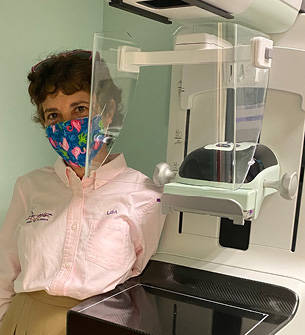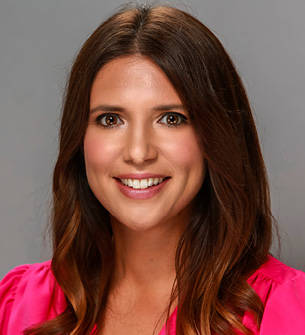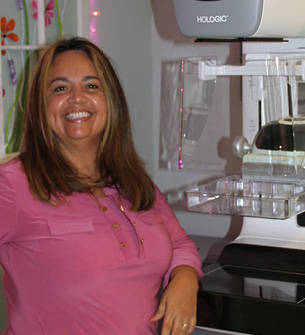-
A nonprofit organization in Florida is building a network of local breast and cervical care providers as well as community resources to help patients in underserved communities overcome socioeconomic barriers to care.
-
Dedicated patient navigators are embedded in partnering clinics and community health centers to guide women through every step of their breast cancer journey. The nonprofit also operates its own mammography screening center.
-
In partnership with a local cancer institute, the organization will be enrolling patients in a clinical trial to study the effects of a shortened course of radiation to treat early-stage breast cancer in women of color, who are often underrepresented in medical research.
By detecting breast cancer at an early stage, when patients have more effective therapy options, regular screening mammograms can reduce breast cancer mortality by 40%. Although the ACR recommends annual mammography screening for most women starting at age 40, unfortunately, not all women have easy access to these lifesaving exams.
For women dealing with limited income, insurance gaps, or even transportation issues, the process of pursuing and paying for screening exams can be challenging at best — and a barrier to care at worst. Additionally, many of these women are minorities who, compared to White women, are 72% more likely to be diagnosed with invasive breast cancer, 58% more likely to be diagnosed with advance-stage disease, and 127% more likely to die from breast cancer — all before age 50.1
 Nancy G. Brinker co-founded the Promise Fund of Florida with the goal of stopping cancer progression and eliminating preventable deaths among women in Palm Beach County. |
“Women with limited resources have limited access to healthcare, so we need to deliver services efficiently at the lowest cost and highest value,” Brinker says. “Frankly, cancer therapy is way too expensive for most people, so detecting disease as early as possible will not just reduce the cost of care but also reduce the confusion that often makes a woman reject services because they’re too complicated to navigate.”
To this end, the nonprofit organization uses a unique patient navigation model that leverages a network of local care providers and community resources — including financial assistance, transportation, translation, and childcare services — to guide women through the breast health journey. In 2020, it also opened its own mammography screening center to better serve women in the area.
“Our mission is to implement a continuum of care,” says Lisa Hartstein, MHS, Promise Fund’s director of programs. “Women who face a broken, fragmented, convoluted healthcare system deserve timely, effective, and efficient healthcare regardless of their insurance status or socioeconomic circumstances.”
Care Navigation
When Brinker relocated to Florida, she realized that the state had one of the highest rates of uninsured women in the country, which magnifies their vulnerability to delayed cancer diagnosis and treatment.2 She co-founded the Promise Fund to help. With more than 80,000 uninsured women in Palm Beach County, the Promise Fund focuses its support where it’s needed most. The nonprofit identifies communities with high populations of women who lack insurance and reaches out to local clinics and community health centers in those neighborhoods to establish partnerships.“The Promise Fund of Florida was founded to address the needs of uninsured and underinsured women in our community, the majority of whom are women of color,” says Karen Patti, MS, chief operating officer. “We aim to ensure that these women can access the services they need to survive.”
 Lisa Hartstein, MHS, director of programs for the Promise Fund, is committed to ensuring all women receive timely and effective care. |
“If a patient walks into one of our partner clinics to receive services, they’ll get connected to the organization’s patient navigator to see if they qualify for our program,” explains Lissette Lahoz, MPH, who coordinates the Promise Fund’s 10 patient navigators as the organization’s director of patient navigation and community engagement.
To meet the program’s criteria, women must reside in Palm Beach County and have income 200% below the federal poverty level. (That’s $53,000 for a family of four.) Although most of these women are uninsured, the program also supports underinsured women who cannot afford medical care. Once a woman is found eligible for the program, she must sign a consent form to enroll.
Due to financial constraints and other factors, many of these women struggle to regularly visit a doctor and usually lack a primary care provider. With this in mind, the navigators’ first step is to secure each patient’s medical home at a local free clinic or Federally Qualified Health Center (FQHC) that provides primary care — with fees determined on a sliding scale according to income.
Establishing a primary care physician is critical to facilitate an order for an annual screening exam and also to build a long-term culture of preventative care, Patti says. “To shift the way our nation looks at medicine, there has to be a focus on preventative care,” she says. “And without annual visits to your doctor, that shift is never going to happen.”
Beyond the Clinic
To effectively reach women who don’t have a primary care physician, the patient navigators can’t just wait for patients to walk into the clinics. The Promise Fund conducts extensive community outreach to engage with women in the neighborhoods where they live.“We want to make people aware of the services we’re providing,” Patti explains. “Part of the patient navigators’ responsibility is to seek opportunities to engage potential participants, whether through community events or religious organizations. It’s so important that our navigators develop trust in their communities while providing solid education to the participants that we intend to serve — and building that trust can’t be done without face-to-face interaction.”
The Promise Fund’s navigators partner with churches, libraries, food pantries, and other community organizations located near each clinic. They also participate in health fairs, where they meet with women and give presentations about the program and the importance of annual mammography screening.
Most of the program’s patient navigators are bilingual in either Spanish or Creole, ensuring that they can communicate with women throughout Palm Beach County — where nearly a third of the residents speak a language other than English at home. “Face-to-face interactions are important to overcoming cultural barriers and making patients feel comfortable with regular screening,” Patti says. “Without that trust, these women may never get screened.”
Improved Access
After establishing each patient’s medical home and securing the necessary referrals, the Promise Fund’s navigators help women coordinate their annual screening mammograms. A primary issue is figuring out how to cover the cost of the exam.First, the navigator determines whether the patient qualifies for an existing assistance program in the state, such as the Florida Breast and Cervical Cancer Early Detection Program, which provides free screenings to women over 50 who qualify. The navigator also checks to see whether patients qualify for specialty care services through the Health Care District of Palm Beach County, which serves patients who lack insurance coverage, whose household incomes are 100% below the federal poverty level, and who don’t qualify for other public assistance.
 Karen Patti, MS, chief operating officer for the Promise Fund, says that the organization was founded to meet the needs of uninsured and underinsured women. |
After making every effort to connect patients to existing community resources, the navigators can turn to the Promise Fund’s own financial assistance program, which provides funding that allows some of its partnering health organizations to subsidize the cost of care for women who don’t qualify for any other assistance.
“Without subsidized care, many women don’t have access to convenient or affordable screening mammograms,” Brinker explains. “This model plays a very important role in health equity by using the resources we have in our community and adding only what we need to add to make a big difference.”
The Promise Fund continues to expand its network of partnering organizations with funding from individual donations, corporate sponsorships, fundraising events, and grants. In the fall of 2021, the organization added a director of provider recruitment, who will secure partnerships with more providers to subsidize care for underserved patients.
“We’re trying to synthesize all of these resources so that, regardless of which organization a patient goes to, everyone has a pathway to receive cancer screening, diagnosis, and care with the best outcomes possible,” Hartstein says. “Our vision is to build a comprehensive continuum of care that makes the healthcare system as seamless as possible for patients.”
Comprehensive Support
In some cases, scheduling the screening mammography is relatively simple compared to the successive hurdles that underserved women must overcome to access comprehensive breast care. That’s why the Promise Fund’s patient navigators take a long-term approach to laying out a course for patients to follow beyond the initial mammogram, through subsequent follow-up imaging, diagnostic testing, and treatment.“It’s not just a referral to a screening center,” Lahoz explains. “We want to make sure all of the dots are connected for our patients. So, the patient navigator stays with the patient all the way through their care to make sure they get to their mammography screening appointment. If the results indicate a need for further testing, then the patient navigator connects the patient to the next step — holding their hand through the whole process.”
 Lissette Lahoz, MPH, director of patient navigation and community engagement, coordinates the Promise Fund’s 10 patient navigators. |
To mitigate these travel challenges, navigators help patients coordinate rides to their appointments through popular healthcare transportation apps or rideshare services at partnering facilities. In some cases, the navigators even drive patients themselves. “One of our patients needed to go to Moffitt for a two-day evaluation to determine her treatment options,” Lahoz explains. “So the navigator drove her all the way there, and the Promise Fund provided travel reimbursements and paid for the navigator to stay there to provide interpretation until the patient came home.”
In addition to transportation, the navigators sometimes help women arrange childcare so that they can attend their appointments or connect women to local pantries where they can obtain food to feed their families. “We look at the whole person to break down all the barriers to health,” Hartstein says.
Expanded Reach
In October of 2020, the Promise Fund took its comprehensive approach to care a step further when it expanded its partnership with FoundCare Inc., a nonprofit FQHC and one of the Promise Fund’s two initial partner organizations. In doing so, the Promise Fund established a screening center within FoundCare’s new women’s health department in West Palm Beach. The ACR-accredited center provides free and discounted screening mammograms for uninsured patients, using a 3D-mammography machine that a medical technology company donated.“Any uninsured woman who is over 40 — or under the age of 40 with a family history of cancer or with a prescription from a medical provider — receives a screening mammography at a subsidized rate, so she doesn’t have to pay for the mammogram,” says Janet Abramowitz, mammography coordinator at the Promise Fund Mammography Screening Center at FoundCare. “Some of these women are 55 or 60 years old and have never had a mammogram.
To further its mission of health equity, the Promise Fund is also working to increase representation of women from minority populations in clinical trials of radiology treatments for breast cancer. To that end, the organization is partnering with the Miami Cancer Institute at Baptist Health South Florida to participate in a clinical trial that will study the effects of a shortened course of radiation to treat early-stage breast cancer in women from minority populations.
“Women of color are disproportionately left out of many clinical trials, so there isn’t enough research to support whether certain treatments are effective for these patients,” Patti says. “We need to include individuals of color in more clinical trials because we’re not all genetically made the same. Everyone’s body responds differently to different treatment, and we need to distinguish these differences through scientific research in order to improve outcomes for all women.”
Replicable Model
Since its founding in 2018, the Promise Fund has helped more than 2,500 women in Palm Beach County connect to clinical services. Patient navigators have guided 61 women through cancer treatment and helped them access affordable care options, regardless of their income or insurance.“Research has proven that patients who are connected with a live patient navigator have much better outcomes than those who don’t,”3 Patti says. “Plus, patient navigators can help ensure that women are screened early and have access to treatment before diseases progress, reducing healthcare costs.”
While the Promise Fund focuses on expanding its network of local partners to serve more women in Palm Beach County, the organization’s leaders see plenty of potential for this type of program beyond South Florida. “In the long term, we would like to make this a replicable model so that other communities throughout the nation can ensure that women get the care they need,” Patti says. “We want to show that there is value in aggregating existing community services to better serve patients.”
Promise Fund leaders see value in this model on the international level, as well. In fact, a member of the Promise Fund’s board of directors who served as an ambassador to Qatar leveraged his relationships to connect the Promise Fund with the Qatar Cancer Society. During a virtual symposium, representatives from the Promise Fund and the Miami Cancer Institute presented details about the program’s model of patient navigation while providers from Qatar explained their country’s approach to cancer treatment.
“It’s a really exciting partnership that we intend to continue because cancer is a global issue,” Patti says. “Learning from each other can highlight ways that we can judiciously improve the services and quality of care that we’re rendering in the United States. This is a model that anyone anywhere can potentially implement to help women everywhere live healthier lives.”
End Notes
1. Monticciolo, DL et al. (2021). Breast cancer screening recommendations inclusive of all women at average risk: update from the ACR and Society of Breast Imaging. J Am Coll Radiol. 2021 Sep;18(9):P1280-1288. https://doi.org/10.1016/j.jacr.2021.04.021
2. Cohen, RA et al. (August 2021). Geographic variation in health insurance coverage: United States, 2019. (No. 163) National Health Statistics Reports. https://www.cdc.gov/nchs/data/nhsr/nhsr163-508.pdf
3. Natale-Pereira A, Enard KR, Nevarez L, Jones LA. The role of patient navigators in eliminating health disparities. Cancer. 2011 Aug;117(15 Suppl):3543-52. doi: 10.1002/cncr.26264
Creative Commons
Improving Access to Women by American College of Radiology is licensed under a Creative Commons Attribution-NonCommercial-NoDerivatives 4.0 International License. Based on a work at www.acr.org/imaging 3. Permissions beyond the scope of this license may be available at www.acr.org/Legal.
Share Your Story
Have a case study idea you’d like to share with the radiology community? To submit your idea please click here.
Now It's Your Turn
Follow these steps to engage future radiologists, and tell us how you did at imaging3@acr.org or on Twitter with the hashtag #Imaging3 :
- Evaluate how your organization is reaching and serving women who face socioeconomic barriers to accessing breast cancer and other types of screening, diagnosis, and treatment.
- Collaborate with local clinics, community health centers, and social service organizations in your area to streamline the path for underserved patients to access breast and other types of healthcare.
- Employ dedicated patient navigators to guide patients through siloed health systems and social services by providing personalized support to bridge the gaps in care.
Author
Brooke Bilyj, freelance writer
Join the Discussion

#Imaging3 on Twitter
Call for Case Studies
